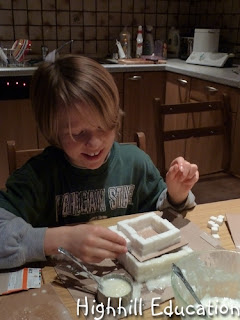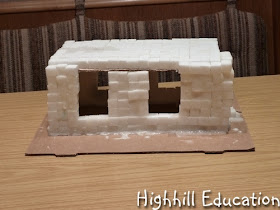Babylon was an ancient Mesopotamian city and also an Empire. Actually it was an empire twice. We began our history lesson talking about Hammurabi. He was a Babylonian King and the first person in history who wrote down the laws of his land. We watched this 3 minute video about the Law Code Stele of Hammurabi.
Nebuchadnezzar was the name given to two Kings of Babylon. Nebuchadnezzar II ruled the second Babylonian empire. He exiled the Jews because they wouldn't worship him and built the Hanging Gardens of Babylon. He called himself a favorite of the Gods.
In many European cities churches mark the center of town. Temples and amphitheaters marked the center of Roman towns and ziggurats marked the center of cities in Mesopotamia. A ziggurat is a stepped pyramid containing between two and seven layers built to honor the god of the city, and as an astronomical lookout. They were found all over the Mesopotamian region in what is today known as Iran and Iraq. Priests were the only members of society permitted in the ziggurats.
All of our structures were built using sugar cubes, cardboard and icing glue.
Icing Glue Recipe
6 egg whites
2 lb powdered sugar
1 tsp cream of tarter
Ziggurat
Zoning of land in many American locations is a common practice. In Mesopotamia, the wealthiest citizens had houses closest to the ziggurats and the servants lived in smaller homes farther away.
The homes had flat roofs and were constructed of mud bricks.
Here is a home of a middle income family.
Each city in Mesopotamia had it's own God or Goddess. The Goddess of Babylon was Ishtar. Hence the Ishtar gate. The Ishtar gate existed during the second Babylonian Empire.
It was one of the many gated entrances to the city and bright blue in color. The entrance was lined with pictures of lions, and other animals.
This 7 minute video - Ishtar Gate and Processional Way explains the gate much better.
It has been relocated to a museum in Berlin, Germany and we hope to visit it one day as it's only about ten hours away from where we live.
To see our other history activities please visit our history page.









Great project. We did a similar one making the Egyptian pyramids with sugar cubes!
ReplyDeleteLove this project! The houses they made are fantastic! We made a pyramid out of sugar cubes long ago. It was fun, though the main thing I remember was how expensive sugar cubes are here. Not sure if they are more reasonably priced where you are but here they were pricey.
ReplyDeleteThanks so much for linking up at the Real Family Fun link party! Hope to see you next week.
KC
They were about $1.50 per box and each child used a little more than a box.
DeleteMy kids would LOVE this. Great idea for when we cover this material in school.
ReplyDeleteDana @ http://dana-projectday.blogspot.com/